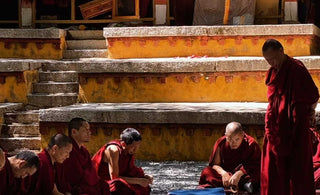
Padmasambhava, a revered figure in Tibetan Buddhism, stands as a pivotal icon whose contributions have profoundly shaped the evolution and spiritual practices within this ancient tradition. This revered master, also known as Guru Rinpoche, holds a significant place in the hearts of practitioners and scholars alike, transcending time with his enduring legacy.
The Life and Origin of Padmasambhava
Padmasambhava, a revered figure in Tibetan Buddhism, emerges from the enigmatic depths of legend and spirituality, shrouded in celestial mysteries. Born in the 8th century in the Swat Valley, which was then part of India and now Pakistan, his arrival into the world was marked by extraordinary signs and auspicious occurrences. Legend holds that Padmasambhava didn’t have a conventional birth but emerged from a cosmic lotus, an auspicious and divine manifestation.
His youth was characterized by a deep inclination toward spiritual pursuits and a thirst for knowledge. His journey toward enlightenment led him to various teachers, absorbing wisdom from multiple spiritual traditions, mastering the intricacies of various philosophies and practices.
Padmasambhava's life took a momentous turn when invited to Tibet by King Trisong Detsen to subdue malevolent forces that obstructed the spread of Buddhism. He skillfully tamed these negative energies and established the foundation of Buddhism in Tibet, setting the stage for its profound and lasting influence.
Guru Rinpoche’s teachings were not limited to scholarly discourses but encompassed a holistic approach, blending profound wisdom with practical applications. His spiritual prowess extended beyond scholarly knowledge, with miraculous demonstrations of his enlightened nature that captivated the hearts of all who encountered him.
His life became synonymous with compassionate deeds, miraculous feats, and spiritual teachings. His exploits and teachings are preserved in the treasure troves of ancient scriptures, revealing the depth of his spiritual insights and his invaluable contributions to Tibetan Buddhism.
Padmasambhava's life exemplified the transformative power of enlightenment and the boundless potential of spiritual realization. His journey from the cosmic lotus to the Himalayan heights of spiritual enlightenment remains an awe-inspiring tale, guiding countless practitioners on their own path to spiritual awakening.
Padmasambhava's Teachings and Contributions
Guru Rinpoche's teachings revolved around the profound philosophy of Vajrayana, emphasizing the liberation of sentient beings. His legacy spans a multitude of teachings, including the renowned "Eight Manifestations of Guru Rinpoche," each portraying a distinct aspect of his enlightened nature. He introduced the Tantric teachings, known as Vajrayana, offering profound spiritual practices aimed at swift enlightenment.
Padmasambhava's Cultural and Artistic Influence
Padmasambhava's Cultural and Artistic Influence extended far beyond his spiritual teachings, encompassing a profound impact on the realms of art and culture within Tibetan Buddhism. His divine presence inspired a renaissance in artistic expression, igniting a flourishing period of creativity and devotion.
The revered master was not only a spiritual guide but also an artistic luminary. He fostered a vibrant artistic legacy through the creation of exquisite sacred art forms. From intricately detailed thangkas and meticulously crafted statues to elaborate mandalas, each creation embodied spiritual depth and symbolism. Padmasambhava's artistic prowess transcended mere aesthetics; every stroke and symbol within his art held profound spiritual significance, serving as visual representations of the path to enlightenment.
His artistic influence continues to resonate in contemporary oriental artistry. Artists, inspired by his spiritual essence and artistic brilliance, continue to draw inspiration from his creations. By emulating his style and infusing their works with spiritual symbolism, they pay homage to Padmasambhava's cultural influence, ensuring that his artistic legacy persists, enriching the tapestry of Tibetan art and culture for generations to come.
Padmasambhava's Importance in Tibetan Buddhism Today
Padmasambhava's enduring significance in contemporary Tibetan Buddhism remains profound and multifaceted. His teachings, often referred to as the "heart essence," continue to reverberate within the spiritual fabric of this ancient tradition. The principles he imparted, emphasizing compassion, wisdom, and the path to enlightenment, serve as guiding lights for practitioners worldwide.
In the present day, Padmasambhava's spiritual presence remains vivid through sacred sites, monasteries, and pilgrimage destinations associated with his profound legacy. Devotees embark on journeys to these hallowed grounds, seeking blessings and spiritual insights, fostering a continued connection to Guru Rinpoche's teachings.
Moreover, Padmasambhava's influence extends beyond religious boundaries, permeating cultural and artistic spheres. His artistic legacy, manifested through thangkas, statues, and intricately designed mandalas, serves as a testament to the union of spirituality and artistry within Tibetan culture. This artistic tradition inspired by Guru Rinpoche's teachings continues to thrive, captivating artists, scholars, and enthusiasts globally.
At Oriental Aesthetics, we honor and cherish the profound oriental legacy. We strive to uphold his teachings and artistic contributions by providing systematic, high-quality professional services for oriental artists, collectors, and enthusiasts who appreciate and love classical oriental art.























